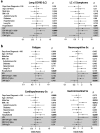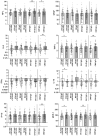This is a preprint.
Impact of Pre-Existing Chronic Viral Infection and Reactivation on the Development of Long COVID
- PMID: 35898346
- PMCID: PMC9327632
- DOI: 10.1101/2022.06.21.22276660
Impact of Pre-Existing Chronic Viral Infection and Reactivation on the Development of Long COVID
Update in
-
Chronic viral coinfections differentially affect the likelihood of developing long COVID.J Clin Invest. 2023 Feb 1;133(3):e163669. doi: 10.1172/JCI163669. J Clin Invest. 2023. PMID: 36454631 Free PMC article.
Abstract
The presence and reactivation of chronic viral infections such as Epstein-Barr virus (EBV), cytomegalovirus (CMV) and human immunodeficiency virus (HIV) have been proposed as potential contributors to Long COVID (LC), but studies in well-characterized post-acute cohorts of individuals with COVID-19 over a longer time course consistent with current case definitions of LC are limited. In a cohort of 280 adults with prior SARS-CoV-2 infection, we observed that LC symptoms such as fatigue and neurocognitive dysfunction at a median of 4 months following initial diagnosis were independently associated with serological evidence of recent EBV reactivation (early antigen-D [EA-D] IgG positivity) or high nuclear antigen IgG levels, but not with ongoing EBV viremia. Evidence of EBV reactivation (EA-D IgG) was most strongly associated with fatigue (OR 2.12). Underlying HIV infection was also independently associated with neurocognitive LC (OR 2.5). Interestingly, participants who had serologic evidence of prior CMV infection were less likely to develop neurocognitive LC (OR 0.52) and tended to have less severe (>5 symptoms reported) LC (OR 0.44). Overall, these findings suggest differential effects of chronic viral co-infections on the likelihood of developing LC and predicted distinct syndromic patterns. Further assessment during the acute phase of COVID-19 is warranted.
Summary: The authors found that Long COVID symptoms in a post-acute cohort were associated with serological evidence of recent EBV reactivation and pre-existing HIV infection when adjusted for participant factors, sample timing, comorbid conditions and prior hospitalization, whereas underlying CMV infection was associated with a decreased risk of Long COVID.
Figures



Similar articles
-
Chronic viral coinfections differentially affect the likelihood of developing long COVID.J Clin Invest. 2023 Feb 1;133(3):e163669. doi: 10.1172/JCI163669. J Clin Invest. 2023. PMID: 36454631 Free PMC article.
-
Signs and symptoms to determine if a patient presenting in primary care or hospital outpatient settings has COVID-19.Cochrane Database Syst Rev. 2022 May 20;5(5):CD013665. doi: 10.1002/14651858.CD013665.pub3. Cochrane Database Syst Rev. 2022. PMID: 35593186 Free PMC article.
-
Antibody tests for identification of current and past infection with SARS-CoV-2.Cochrane Database Syst Rev. 2022 Nov 17;11(11):CD013652. doi: 10.1002/14651858.CD013652.pub2. Cochrane Database Syst Rev. 2022. PMID: 36394900 Free PMC article.
-
Rapid, point-of-care antigen tests for diagnosis of SARS-CoV-2 infection.Cochrane Database Syst Rev. 2022 Jul 22;7(7):CD013705. doi: 10.1002/14651858.CD013705.pub3. Cochrane Database Syst Rev. 2022. PMID: 35866452 Free PMC article.
-
Laboratory-based molecular test alternatives to RT-PCR for the diagnosis of SARS-CoV-2 infection.Cochrane Database Syst Rev. 2024 Oct 14;10(10):CD015618. doi: 10.1002/14651858.CD015618. Cochrane Database Syst Rev. 2024. PMID: 39400904
References
-
- A clinical case definition of post COVID-19 condition by a Delphi consensus, 6 October 20212021;https://www.who.int/publications/i/item/WHO-2019-nCoV-Post_COVID-19_cond.... cited June 16, 2022 - PMC - PubMed
-
- Phetsouphanh C, et al. Immunological dysfunction persists for 8 months following initial mild-to-moderate SARS-CoV-2 infection. Nat. Immunol. 2022;1–7. - PubMed
Publication types
Grants and funding
LinkOut - more resources
Full Text Sources
Miscellaneous
